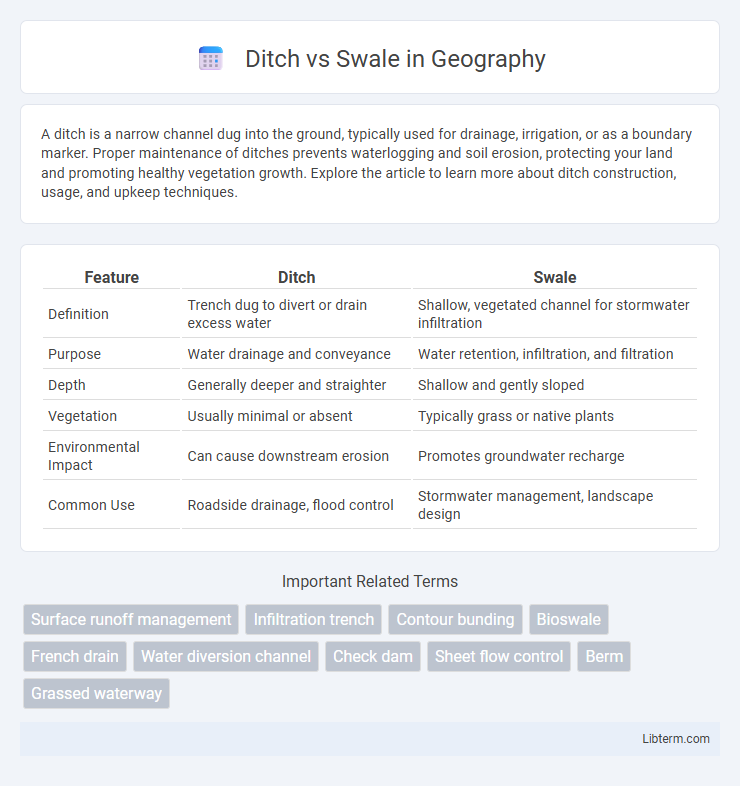A ditch is a narrow channel dug into the ground, typically used for drainage, irrigation, or as a boundary marker. Proper maintenance of ditches prevents waterlogging and soil erosion, protecting your land and promoting healthy vegetation growth. Explore the article to learn more about ditch construction, usage, and upkeep techniques.
Table of Comparison
| Feature | Ditch | Swale |
|---|---|---|
| Definition | Trench dug to divert or drain excess water | Shallow, vegetated channel for stormwater infiltration |
| Purpose | Water drainage and conveyance | Water retention, infiltration, and filtration |
| Depth | Generally deeper and straighter | Shallow and gently sloped |
| Vegetation | Usually minimal or absent | Typically grass or native plants |
| Environmental Impact | Can cause downstream erosion | Promotes groundwater recharge |
| Common Use | Roadside drainage, flood control | Stormwater management, landscape design |
Introduction: Ditch vs Swale
A ditch is a narrow excavation typically used for drainage or irrigation, designed to channel water away from roads or fields efficiently. A swale is a shallow, broad, and vegetated channel that promotes water infiltration and controls runoff, often used in sustainable landscaping and stormwater management. Both ditches and swales serve crucial roles in water management but differ significantly in design, function, and environmental impact.
Defining Ditches
Ditches are narrow, excavated channels designed primarily for the rapid drainage of surface water away from roads, fields, or construction sites to prevent flooding and erosion. They typically have steep sides and a consistent gradient to facilitate swift water flow, often lined with grass, rocks, or concrete to reduce soil erosion. Unlike swales, ditches prioritize efficient water conveyance rather than water infiltration or filtration.
Understanding Swales
Swales are shallow, vegetated channels designed to manage stormwater runoff by promoting infiltration and reducing erosion, differing from ditches primarily in their ecological function and design. Unlike ditches, which are often engineered for rapid water conveyance and drainage, swales integrate natural landscaping elements to filter pollutants and support groundwater recharge. Effective swale design incorporates specific soil types, slope gradients, and native plant species to optimize water absorption and enhance sustainable stormwater management.
Key Differences Between Ditch and Swale
A ditch is a narrow, often deeper trench designed primarily for drainage or irrigation, typically with steeper sides to quickly channel water away from roads or fields. In contrast, a swale is a shallow, vegetated, and gently sloped depression that slows water runoff, promoting infiltration and reducing erosion. Key differences include their design purpose, depth, vegetation presence, and ability to manage stormwater naturally versus rapid drainage.
Hydrological Functions: Ditch vs Swale
Ditches primarily serve as engineered channels designed to rapidly convey stormwater away from roads and fields, focusing on efficient drainage with minimal infiltration. Swales are shallow, vegetated channels that promote stormwater detention, filtration, and groundwater recharge through natural infiltration and sediment capture. Their hydrological functions differ as ditches prioritize quick water removal, while swales enhance water quality and reduce runoff volume by mimicking natural hydrologic processes.
Best Use Cases for Ditches
Ditches are best used for efficiently channeling runoff water away from roads, agricultural fields, and construction sites to prevent erosion and flooding. They provide rapid drainage in areas with high rainfall or heavy water flow, making them ideal for roadside drainage and stormwater management. Properly designed ditches reduce water pooling and soil saturation, protecting infrastructure and supporting land stability.
Best Use Cases for Swales
Swales are best suited for managing stormwater in urban and suburban landscapes by promoting infiltration and reducing surface runoff. These shallow, vegetated channels slow water flow, filter pollutants, and recharge groundwater, making them ideal for residential areas, parks, and commercial developments. Unlike ditches, swales enhance natural water absorption and support ecosystem health without requiring extensive maintenance or concrete lining.
Environmental Impact Comparison
Ditches primarily channel water quickly away from an area, often leading to increased runoff and potential downstream erosion, while swales slow water flow and facilitate groundwater recharge, reducing erosion and filtering pollutants. Swales support biodiversity by providing habitat and improving water quality through natural filtration, whereas ditches tend to offer limited ecological benefits. Environmentally, swales promote sustainable stormwater management by enhancing infiltration and decreasing flood risks compared to traditional ditches.
Maintenance Requirements of Ditches vs Swales
Ditches require regular clearing of debris, sediment, and vegetation to maintain proper water flow and prevent blockages, demanding periodic inspection and excavation. Swales, designed for infiltration and stormwater management, need routine mowing, sediment removal, and vegetation management to sustain their water absorption capacity and prevent erosion. Proper maintenance of both structures is essential to ensure effective drainage and reduce flood risks in landscapes and urban areas.
Choosing Between a Ditch and a Swale
Choosing between a ditch and a swale depends on site conditions, water flow volume, and environmental impact. Ditches are linear channels designed for rapid drainage of larger stormwater volumes, often concrete-lined for durability but can cause erosion. Swales, by contrast, are vegetated, shallow depressions that promote infiltration, reduce runoff velocity, and support groundwater recharge, making them ideal for sustainable stormwater management on residential or low-impact developments.
Ditch Infographic

 libterm.com
libterm.com